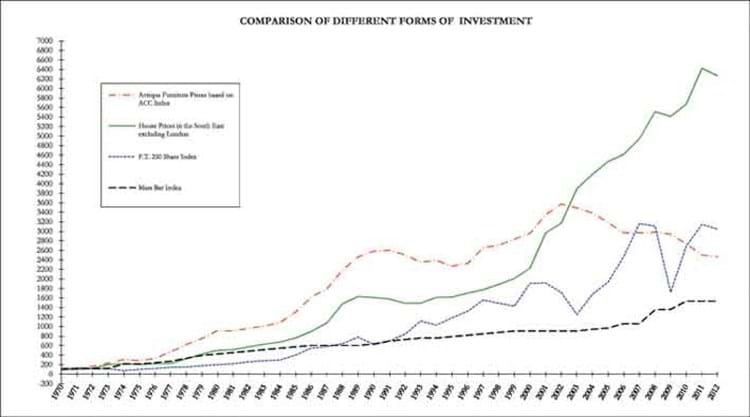
While, for reasons of fashion and function, the English antique furniture market remains in a parlous state, the decline was no more severe than those seen on the stock exchange or the housing market.
Established in 1968, the AFI is based on a blend of retail and auction prices for 1400 typical (rather than exceptional) pieces of furniture from seven different periods or categories pictured in John Andrews' book British Antique Furniture. It does not reflect the volume of items traded, nor does it include spectacular sales at the top end of the market where prices largely held up well.
The index stood at 100 when Mr Andrews began the project and it reached an historic high of 3575 points in 2002. But the past decade has seen a steady decline, including record falls of seven per cent in 2009 and eight per cent in 2010. Last year, the index moved downwards again from 2505 to 2463. It was last at this level in 1995.
Five of the seven constituent indices of the AFI registered falls in 2011. The categories most associated with the decline in formal dining, Late Mahogany (-3%) and Regency (-3%), show few signs of returning to form, while falling demand for dressers and a lack of good examples meant Oak (-2%) and Country (-4%) again showed the new-found vulnerability that marked them among the biggest losers in 2010.
Across 43 years, oak and country have been the strongest of all categories, but post-1770 mahogany furniture now carries the lowest of all index figures at 1803.
The Early Mahogany category saw a small gain (+1%) and Walnut, which fell 7% in 2010, was up by 5% in 2011, something Mr Andrews attributed to a very limited supply.
"There was a shortage of quality in the auction rooms, where routine antique furniture continued to be in poor demand," he said.
Early Victorian pieces were again the biggest loser at -8%.
Only items that were well above average in terms of design and quality, or those with an attractive provenance, maintained their values.
The separate Victorian & Edwardian Index, started in 1973 and once the recipient of spectacular gains, continues to nosedive, dropping a further 11%, mirroring double-digit falls in recent years. While some forms remain strong, such as the upholstered tub chairs popular with interior decorators, other standard late 19th and early 20th century pieces, such as the davenport, the work table and the credenza still languish among the unfashionable.
The Victorian & Edwardian Index, which stood at 2031 in 2003, has lost more than half of its value during the tailspin of the past decade. It now stands at 871, below the index figure it held in 1988.
Nevertheless, given the modest fall in the overall index, Mr Andrews finds some cause for optimism, particularly when measuring the AFI against comparable indices for the FT250 Share Index or the average house price in the south east of England.
"In today's economic circumstances it could have been much worse," he concluded.
Reports from the 'factory floor' during the final quarter of 2011 were also cause for some encouragement. Paul Viney, chairman of the Society of Fine Art Auctioneers, commented in January: "An aspect I have noticed in the last few months is that English furniture has become more sought after, though whether this is merely a blip or represents an encouraging emergence from the doldrums of the last few years, it's difficult to say."
A fuller analysis of the AFI numbers is published in the February edition of Antique Collectors' Club magazine Antique Collecting.




